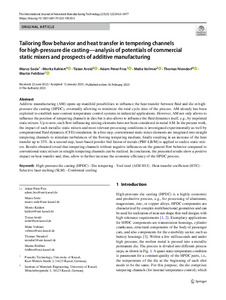| dc.date.accessioned | 2023-04-12T09:38:35Z | |
| dc.date.available | 2023-04-12T09:38:35Z | |
| dc.date.issued | 2023-02-16 | |
| dc.identifier | doi:10.17170/kobra-202304057779 | |
| dc.identifier.uri | http://hdl.handle.net/123456789/14579 | |
| dc.description.sponsorship | Gefördert im Rahmen des Projekts DEAL | ger |
| dc.language.iso | eng | eng |
| dc.rights | Namensnennung 4.0 International | * |
| dc.rights.uri | http://creativecommons.org/licenses/by/4.0/ | * |
| dc.subject | high-pressure die casting (HPDC) | eng |
| dc.subject | die tempering | eng |
| dc.subject | tool steel (AISI H13) | eng |
| dc.subject | heat transfer coefficient (HTC) | eng |
| dc.subject | selective laser melting (SLM) | eng |
| dc.subject | conformal cooling | eng |
| dc.subject.ddc | 620 | |
| dc.subject.ddc | 660 | |
| dc.title | Tailoring flow behavior and heat transfer in tempering channels for high-pressure die casting—analysis of potentials of commercial static mixers and prospects of additive manufacturing | eng |
| dc.type | Aufsatz | |
| dcterms.abstract | Additive manufacturing (AM) opens up manifold possibilities to influence the heat transfer between fluid and die in high-pressure die casting (HPDC), eventually allowing to minimize the total cycle time of the process. AM already has been exploited to establish near-contour temperature control systems in industrial applications. However, AM not only allows to influence the position of tempering channels in dies but it also allows to influence the fluid dynamics itself, e.g., by imprinted static mixers. Up to now, such flow-influencing mixing elements have not been considered in metal AM. In the present work, the impact of such metallic static mixers and most relevant processing conditions is investigated experimentally as well by computational fluid dynamics (CFD) simulation. In a first step, conventional static mixer elements are integrated into straight tempering channels to stimulate turbulences of the flowing tempering medium, finally resulting in an increase of the heat transfer up to 33%. In a second step, laser-based powder bed fusion of metals (PBF-LB/M) is applied to realize static mixers. Results obtained reveal that tempering channels without negative influences on the general flow behavior compared to conventional static mixers in straight tempering channels can be realized. In conclusion, the presented results show a positive impact on heat transfer and, thus, allow to further increase the economic efficiency of the HPDC process. | eng |
| dcterms.accessRights | open access | |
| dcterms.creator | Sode, Marco | |
| dcterms.creator | Kahlert, Moritz | |
| dcterms.creator | Arold, Tizian | |
| dcterms.creator | Fros, Adam Peter | |
| dcterms.creator | Vollmer, Malte | |
| dcterms.creator | Niendorf, Thomas | |
| dcterms.creator | Fehlbier, Martin | |
| dc.relation.doi | doi:10.1007/s00170-023-10920-5 | |
| dc.subject.swd | Rapid Prototyping <Fertigung> | ger |
| dc.subject.swd | Druckguss | ger |
| dc.subject.swd | Hochdruck | ger |
| dc.subject.swd | Werkzeugstahl | ger |
| dc.subject.swd | Wärmeübergangszahl | ger |
| dc.subject.swd | Selektives Laserschmelzen | ger |
| dc.type.version | publishedVersion | |
| dcterms.source.identifier | eissn:1433-3015 | |
| dcterms.source.issue | Issue 11-12 | |
| dcterms.source.journal | The International Journal of Advanced Manufacturing Technology | eng |
| dcterms.source.pageinfo | 5463-5477 | |
| dcterms.source.volume | Volume 125 | |
| kup.iskup | false | |


